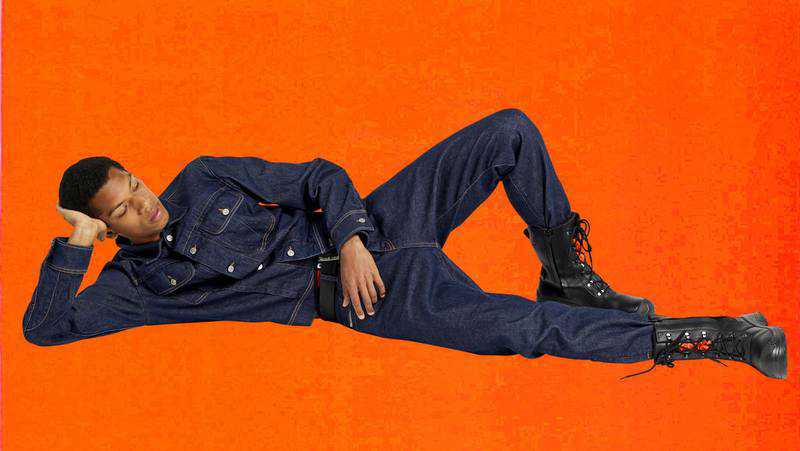The inventive fabrics changing up fashion: from Coreva to mycelium
03 September, 2021

Diesel's new creative director Glenn Martens may not been with the company long, but he's already shaking things up. As part of the For Responsible Living initiative, Martens and Diesel have partnered with Italian denim maker Candiani to create a completely new kind of stretch denim using rubber.
Called Coreva, the fabric employs new technology to turn natural rubber into a stretch yarn strong enough to be added to cotton denim. Plant-based, it is also completely biodegradable, an industry first.
While this may not sound exciting, it is worth noting that other stretch denim relies on elastane to provide the "give". Elastane is made from polyurethane, meaning that while the cotton denim will reach the end of its life and rot away in five months, the plastic will take 450 years to decompose. Presently, an estimated 88 per cent of women's jeans have some element of stretch fibres, making this a global issue.
In response, the new Coreva stretch denim is completely biodegradable and will rot away to nothing. Made using the sap of the rubber plant, it is a natural and renewable material, and will be used in elements of Diesel's autumn 2021 collection.
While this new technology is a welcome addition to the fashion universe, it is not the only innovative fabric that is starting to have an impact on how clothes are made. Here's a look at some others to keep an eye out for.
Eucalyptus yarn
Fabric made from eucalyptus has been around since 2014, but is constantly being updated into new products. Made from the hardy and fast-growing eucalyptus tree, the fibres it produces offer a sustainable and ecological alternative to cotton. Already prized for the oil derived from its leaves, which is both a powerful disinfectant and a strong insecticide, now the wood is being harvested for use as well.
Able to withstand heavy pruning, as long as the roots are left untouched, eucalyptus can regenerate quickly. The wood is pulped and mixed with a non-toxic solvent, amine oxide, to reduce the pulp to a cellulose solution. Forced through tiny nozzles, these fine threads can be spun into yarn commercially known as Tencel. The process needs little water, and 99 per cent of the solvent is reused, making it a closed-loop production system.
Soft and lightweight, the fabric is ideal for clothing that sits next to the skin, and now the knitting supply company Wool and The Gang has created a knitting yarn from the eucalyptus, called the Tina Tape Yarn.
Pinatex
Born as a response to the waste and pollution of traditional leather making and tanning, Pinatex is a leather alternative made entirely from pineapples.
It is made using the unwanted leaves from the fruit that is left behind after harvesting, which until recently used to be left to rot or were burnt. However, thanks to the work of Dr Carmen Hijosa, the leaves are now transformed into a new, durable material.
The leaves are gathered and put through machines that extract the stringy fibres, and then washed and dried in the sun. The tough fibres are then chopped and treated to strip out the impurities, resulting in something akin to cotton wool. The fluff is then mixed with a corn liquid and pressed into a plant-based leather alternative that is hardwearing enough to be used in shoemaking.
An estimated 40,000 tonnes of leaves are generated by pineapple farming each year, and one square metre of Pinatex requires 480 leaves. Gathering the leaves also creates a new revenue stream for farmers. To date, the Hilton London Bankside hotel, H&M and Hugo Boss have all used Pinatex.
Mycelium
Using the complex system inside mushrooms called mycelium, this ingenious material is grown rather than made.
The material was first used by Dutch designer Aniela Hoitink, after she realised that soft organisms like mushrooms grew by replicating themselves on a modular system, much like building blocks.
Essentially an interwined network of fine white filaments, the resulting structure is light and strong. Endlessly repeatable, mycelium simply needs the right environment and food to begin the process, and as long as favourable conditions remain, it will carry on replicating indefinitely.
Hoitink used it to create dresses by growing them as 3D, while earlier this year, Hermes teamed with the US company MycoWorks to create a new version of its Victoria bag, with the pieces grown exactly to size, resulting in zero waste. Stella McCartney has also partnered with another mycelium based company, Bolt Threads, to make a new type of faux leather, called Mylo.
Source: www.thenationalnews.com
TAG(s):
